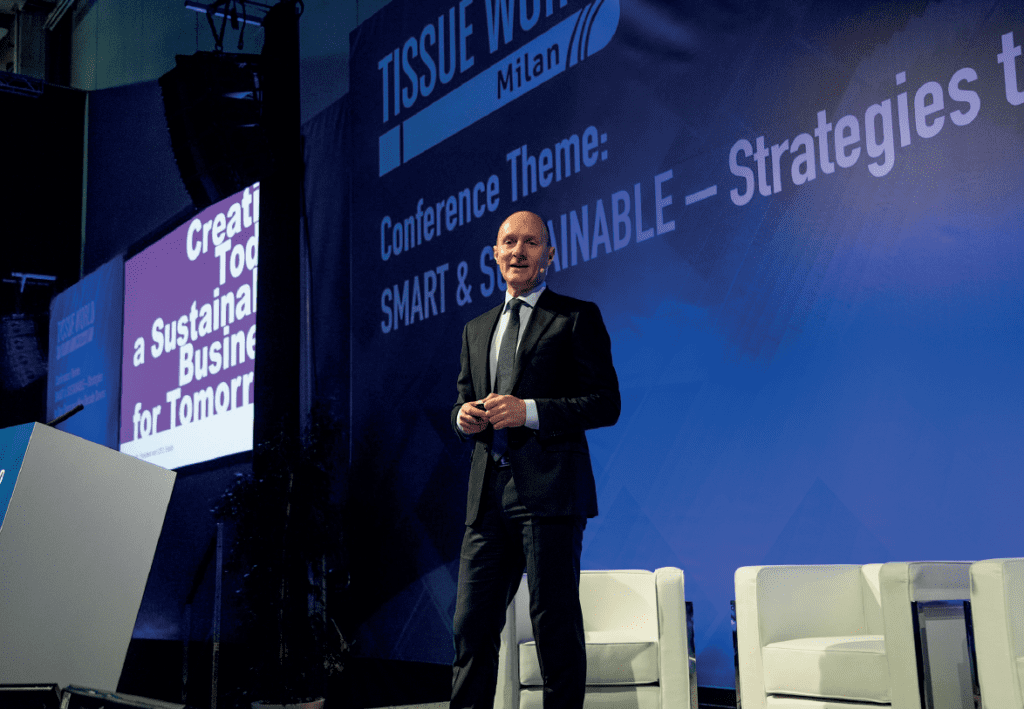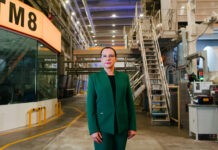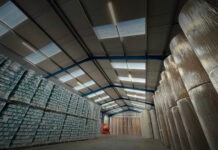In a wide-ranging analysis, Essity president and chief executive Magnus Groth told Tissue World Milan that innovation in the last decade has not been enough. A deeper insight into consumer needs is vital if the
industry is to up its game to attract investors, young talent, and sustainable growth.
“How do we make the industry attractive in the long run, but also with the current issue and challenges that we’re all facing, how do we make it attractive in the short run as well?
“Essity has sales of €12bn and a presence in 150 countries; 60% of its business is in tissue and 40% is in personal care. “Consider yourself an investor now. It’s your money: where would you put your money? In consumer tissue, or in professional hygiene? Or would you maybe put it in incontinence products, a quickly growing category with huge opportunities for innovation. Or medical solutions? The global population is getting older with more chronic conditions. Where would you put your money?
“The key challenges we face as a company and as an industry are:
• The tissue industry is currently not reinvestable;
• There’s a lack of consumer-relevant innovation in mature markets which is commoditising our category;
• Growth in emerging markets requires new technologies and resources. There is a huge growth opportunity in emerging markets, but will we be able to take advantage of that considering the lack of raw materials and the lack of technologies in order to make this possible in a sustainable way;
• Disposable products – an increasing sustainability concern. We’re selling disposable products, and you read every day in the news that disposable products are under a lot of scrutiny now;
• Digitialisation transforms our business. It is a huge challenge and also a big opportunity;
• Talent war – we need to be an attractive industry. In the end, we need to be attractive in order to attract the best talent in the future, and to have this in a positive cycle for the long term.
“These challenges can only be solved by collaboration. No one can do this by themselves. “Why should we invest our money in tissue? One of the main issues we all face at the moment is that the tissue industry isn’t very re-investible today. But I think it can be. We need to work together, starting with profound consumer insights. How can we improve their well-being, how can we improve the customer’s health and hygiene? If it’s a professional customer how can we improve their efficiency? We can do that together with the trade because the trade will have different delivery models, different subscription models, and so on. We need to do it with the equipment suppliers which need to develop the new equipment necessary to really provide the products and services to the consumers. And we, Essity, and the other tissue manufacturers really need to provide for the consumers, but none of us can do it alone.
“In the last decade, there hasn’t been that innovation, other than the continuous improvements and efficiencies, which are all well and good, but we need to see a step change in our industry going forward if we are going to be attractive for young people and for investors.
“As a basic fundamental, the assumption is that sustainability is a key for all of us. At Essity we have now signed up to the Paris agreement target (which in 2015 saw 195 of the world’s governments commit to prevent dangerous climate change by limiting global warming to well below 2 Degrees Celsius), not to have higher global warming by two Degrees Celsius up to 2030. We have also set our targets on reducing greenhouse gases under the scrutiny of the “Science-based targets” initiative (a partnership between CDP, UN Global Compact, WRI and WWF which provides companies with a clearly defined pathway to growth by specifying how much and how quickly they need to reduce their greenhouse gas emissions) and they have approved that if we do achieve the targets we have set for greenhouse gas emission
reductions by 2030, Essity is pulling its weight in making sure that global warming will not be more than two degrees in a little over 10 years’ time. I urge everyone to do the same.
“It is a good opportunity for working together in creating joint projects in order to together reach these targets and creating joint projects.
“The tissue industry is currently not re-investable. Looking at our annual report; this is the annual demand growth in tissue in different markets over the past few years. The main raw material price has developed and Essity’s consumer tissue adjusted EBITDA margin.
“Ask yourself if someone asked you, “This is how my company has performed, will you invest in my company? Would you invest in this if you were an investor?
“Maybe this is the right time to step in, but if you look at the longer term for these growth rates and margin levels … then there are lots of other opportunities out there in the world waiting to be invested in.
“So it’s a little bit provocative but actually in the short term it’s not; if we’re going to get out of this kind of development in the longer term, that’s when we need to work on the other areas here.

“And the key here, number one, is to avoid commoditisation. Consumer brand innovation and it’s not easy. When was the last time there was a product with new technology, something that would really game change the tissue industry? Increasing the growth rates, reducing the environmental impact and making this a better user proposition for the consumers. Our two examples: two recent launches that we did in the last two months:
• Coreless Toipa: there’s no core. There have been products like this before but I haven’t seen anyone yet where the whole stays unchanged, where it doesn’t compress, and this is a huge development we have done with our key suppliers. The benefits from the consumer research are less obvious than you think; the main benefit is that your family will have more peace of mind at home, because there’s no argument in throwing away the tube. Other important benefits – environmental, there’s 6% less material in this product, there’s less waste, and in the countries where packing like this is taxed, there’s less tax for the supplier. So a number of real tangible benefits. This product is really taking off; consumers like it and it is attracting consumers back to brands and away from private label because this is something that is differentiating. It’s attracting consumers who never used brands.
• HHT in a box: tissue in a box. This is our biggest product in China though our subsidiary Vinda, the number one tissue supplier in China with over a billion euro sales and a 16% market share. This is the most common product in China and it is used for everything. You can take it with one hand and it also has a lower environmental footprint because it has no core in the middle and it contains twice as much as a normal household roll.
“These are the types of innovations that together as suppliers but also with the retailers, we need to differentiate. This is the type of innovation we can develop with our equipment suppliers and also with the retailers, to make the tissue shelf a more attractive offering for them. And in the end an additional consumer benefit.
“Growth in the emerging markets requiring new technologies – how will we
be able to grasp this opportunity going forward, with huge opportunities. Tissue consumption per capita, kg/capita: North America: 25.1, Western Europe: 15.8, Japan: 15.7, Oceania: 11.7, Latin America: 6.5, Eastern Europe: 6.0, China: 5.6, Near/Middle East: 4.5, Asia far East: 0.9, Africa: 0.65. Just looking at Vinda in China which has been growing with double digits over the past 10 years, but how long can this continue?
“Last year we had a real supply issue of raw materials in China. With the long lead times, can we be entirely dependent on pulp as a raw material going forward? I don’t think so. There is definitely a need for looking at alternative fibres, alternative processes. Do we really need to grind down the trees and dry them and ship them halfway around the world, and then use them to make tissue and dry them again; is that the only technology? It’s the same we have seen for 100 years. Some of our most efficient plants have equipment that is 60, 70 years old. In how many other industries would you see this today?
“So if we’re going to grasp this growth opportunity, which we are very excited about, then we would also need new technologies sooner rather than later.
“Disposable products and increasing sustainability consumption … tissue is still in a slightly better position than some other disposable products, e.g. personal care’s baby diapers, incontinence products, etc, where most are made of plastics. The starting point is better for tissue, but our business will of course come under pressure.
“I see some opportunities here but we need to work together in our value chain but also with authorities in local, regional and national level.
“A local example from our Lucca, Italy, plant: what will help us when it comes to the recyclability issue, which is difficult for some of our tissue categories, which is to make sure the initial footprint is as small as
possible. Key statistics for the site include: employing 300 people, 75,000 tonnes FP year, 100,000 tonnes MR year, 450,000 MWh energy consumption per year. Achieved: reduced energy consumption by 5%, reduced CO2 emissions by 3%, this CO2 amount can be offset by the planting of 260,000 trees.
“This is an example of day to day improvements that are achieved with very little investments and at a plant that has been around for a long time. Even though we have improved efficiency, sustainability, footprint for many years, there’s still a lot to be done.
“From an innovation angle, Tork PaperCircle is the world’s first recycling service for paper hand towels, and has lowered carbon footprints by up to 40%* and lowers the generated waste of the buildings involved by up to 20%**.
“We have a number of big accounts today, which have put in place extra bins in the washrooms to recycle reused hand towels. These hand towels are then sent to a few dedicated sites that we have provided with small additional investments that make the recycling of handtowels into new tissue possible. And there is huge demand here for this from Commerz bank in Frankfurt, and also pharmaceutical company AstraZeneca. Why are they so eager to do this? Because they are looking at ways to improve their sustainability profile, and we can help them with this.
“For local authorities, this is also a perfect case as this needs to be agreed in
every municipality. It really requires scale, investment and a long-term perspective. It is a huge opportunity.
“Digitalisation: it’s not only a challenge it’s also a huge opportunity. The five or 10 biggest companies in the world today, none of them produce anything. Keep this in mind: Facebook, Amazon, Netflix, Google … it’s the communication platform that is key. You don’t see the producing companies at the top of the world, it used to be General Electric, etc. The big challenge for process industries is to do this right.
“The big end users that are signing up with us, they are doing it because they want to become more digital. They do this to use it as a showcase.
“By being digital and working on sustainable opportunities and investing
more in innovation and working more in collaboration, this is the only way of winning the talent war. The list of most attractive companies for young people to work in does not have many tissue companies, it’s Google and Spotify. We suggest that if you enter a company like Essity, you won’t just be working in digitalisation, we have 100s of people working on digitalisation but also 1000s in innovation and sustainability. It’s just that they haven’t heard about us, and that’s what we need to change. That’s also a message we need to convey in order to win in the really long term.
“Together we can create a sustainable business for tomorrow, but we together need to work in all these different areas.”
*Based on a Life Cycle Assessment (LCA) for Europe, where the avoided processes have been taken into account, conducted by Essity and verified by IVL, Swedish Environmental Research Institute Ltd, 2017
**Based on results from Tork PaperCircleTM pilot customers in Germany and The Netherlands
































